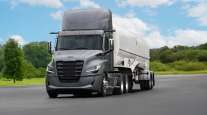Managing Editor, Features and Multimedia
Daimler’s Martin Daum: Autonomous Trucks Will Benefit Industry Without Threatening Jobs

[Stay on top of transportation news: Get TTNews in your inbox.]
ALBUQUERQUE, N.M. — As autonomous trucks gradually move closer to commercialization, Daimler Truck CEO Martin Daum sees this technology delivering a range of benefits for fleet customers and for society at large.
During an April 12 briefing with journalists and analysts, Daum said autonomous trucks will improve highway safety, counter the trucking industry’s driver shortage, boost equipment utilization and help meet rising freight demand.
These highly automated vehicles will be able to operate more safely and more precisely than any human driver, he said, in large part because the autonomous driving system never becomes sleepy or distracted and always follows the rules of the road.
“The virtual driver is the perfect driver, and it’s the perfect driver all the time,” Daum said. “This will ultimately make our travel so much safer.”

Transport Topics' Seth Clevenger and Marissa Gamache take you through the process of determining North America's largest 3PLs in the expanded Transport Topics Top 100 Logistics Companies list. Tune in above or by going to RoadSigns.TTNews.com.
Before the end of this decade, the manufacturer intends to introduce SAE Level 4 trucks capable of operating autonomously on specific routes and within certain parameters without a driver.
Nonetheless, Daum does not see this technology posing a threat to driver jobs.
Rather than attempting to automate all freight lanes, Daimler Truck and its Torc Robotics subsidiary are focusing their efforts on certain stretches of highway that are best suited to autonomous operation.
READ MORE: Torc Demonstrates Progress on Road to Autonomous Trucking
“If everything goes perfectly well, we might put 6% of the U.S. freight in autonomous vehicles,” Daum said. “That means 94% of the freight still needs drivers to be delivered.”
By that time, freight volumes likely will have expanded faster than autonomous truck deployment, meaning the industry will continue to need more drivers, not fewer.
“Therefore, for me, this is not a threat for drivers. This will put nobody in unemployment,” Daum said. “This is absolutely necessary, ultimately, to keep our economy going.”
To ease the introduction of Level 4 trucks, Daimler and Torc are targeting hub-to-hub freight routes that mainly involve driving on stretches of open highway rather than navigating more complex traffic environments in urban areas.
This deployment model breaks a longhaul shipment into three segments. In the long middle-mile section, autonomous trucks would haul trailers on interstate routes between designated logistics hubs situated along highways. Manually driven trucks would continue to handle the first and final legs of the shipment’s journey — from the initial pickup to the first hub and from the second hub to final delivery.
“This is meaningful. This addresses a big need of the industry,” said Peter Vaughan Schmidt, head of Daimler Truck’s Autonomous Technology Group.

Vaughan Schmidt, head of Daimler Truck’s Autonomous Technology Group, discusses the company’s self-driving truck partnerships with Torc Robotics and Waymo. (Seth Clevenger/Transport Topics)
To realize this vision, Daimler Truck is pursuing a “dual-track strategy” by collaborating with two autonomous driving developers.
In addition to its work with Torc, which it acquired in 2019, Daimler Truck also established a separate self-driving truck partnership with Waymo, a unit of Google-parent Alphabet Inc., in 2020.
The truck maker sees the United States as the ideal market to deploy this technology first, due to factors such as long stretches of highway, rising freight demand and a favorable regulatory environment.
“We already have in the U.S. — especially in the West — fairly strong acceptance that the technology is going to occur,” said John O’Leary, CEO of Daimler Truck North America.
Some state governments have been changing their rules to clear the way for developers to test and eventually deploy autonomous vehicles.
“That’s one of the reasons we’re here in New Mexico and why we also go down to Texas,” O’Leary said.
Over time, the manufacturer hopes to see a consistent national regulatory framework emerge for autonomous trucking.
“We really don’t want to see some kind of a patchwork develop,” O’Leary said.
Want more news? Listen to today's daily briefing below or go here for more info:




